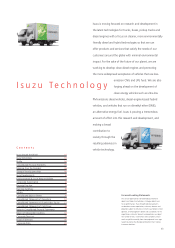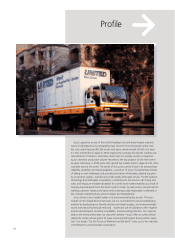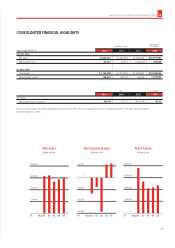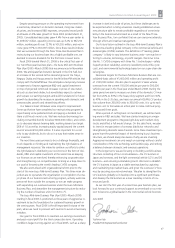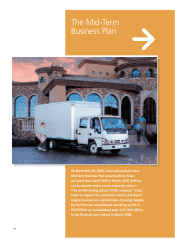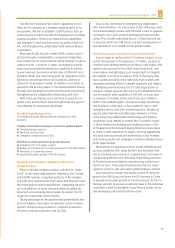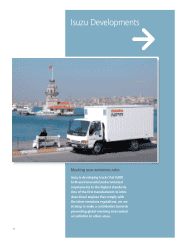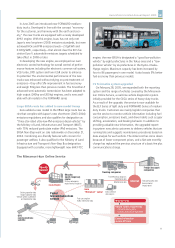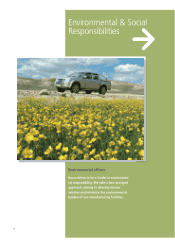Isuzu 2005 Annual Report Download - page 10
Download and view the complete annual report
Please find page 10 of the 2005 Isuzu annual report below. You can navigate through the pages in the report by either clicking on the pages listed below, or by using the keyword search tool below to find specific information within the annual report.
11
In June 2005 we introduced new FORWARD medium-
duty trucks. Developed in line with the concept “economy
for the customer, and harmony with the earth and soci-
ety,” the new trucks are equipped with a newly developed
4HK1 engine. With this engine, Isuzu has not only met
Japan’s new long-term (2005) emissions standards, but even
achieved NOx and PM emissions levels—2.0g/kWh and
0.027g/kWh, respectively—that almost clear the EU’s far-
stricter Euro V automobile emissions targets scheduled to
take effect in 2008 or later.
In developing the new engine, we employed our own
electronic control technology for overall control of perfor-
mance features including the electronic common rail system,
VGS turbo, DPD system and twin EGR cooler to enhance
its potential. The environmental performance of the new
trucks was enhanced without relying on post-treatment of
emissions—they offer 5% improvement in fuel economy
and weigh 50kg less than previous models. The Smoother-F
advanced semi-automatic transmission has been adapted to
high output (240hp and 260hp) engines, and is now avail-
able with all models in the FORWARD series
Large ERGA route bus added to new model lineup
Isuzu added a new model to the ERGA large route bus se-
ries that complies with Japan’s new short-term (2003–2004)
emissions regulations and also qualifies for designation as
“three star-rated ultra-low-PM-emissions diesel vehicles” by
the Ministry of Land, Infrastructure and Transport (MLIT),
with 75% reduced particulate matter (PM) emissions. The
ERGA Non-Step went on sale nationwide on December 21,
2004. Combining eco-friendly features with concern for
passenger welfare, it also qualifies for the Ministry of Land
Infrastructure and Transport’s Non-Step Bus designation.
Equipped with a smaller, more lightweight new 6HK1-TCC
«
Isuzu Motors Limited Annual Report 2005
engine, the new ERGA is designated a “good low-pollution
vehicle” by eight prefectures in the Tokyo area and a “low-
pollution vehicle” by six prefectures in the Kyoto–Osaka–
Hyogo region. Maximum capacity has been increased by
four to 86 passengers in one model. It also boasts 5% better
fuel economy than previous models.
CV Telematics system upgraded
On February 28, 2005, we expanded both the reporting
system and the range of vehicles covered by the Mimamori-
kun Online Service, a real-time vehicle diagnostics system
initially provided for the GIGA series of heavy-duty trucks.
As a result of the upgrade, the service is now available for
the ELF Series of light duty and FORWARD Series of medium
duty trucks. Customers are mainly logistics companies that
use the service to monitor vehicle information including fuel
consumption, emissions levels, and driver habits such as gear
shifting, acceleration, and braking behavior. In addition to
providing valuable new information, the upgraded report-
ing system now alerts customers to delivery vehicles that are
running late and suggests maintenance procedures based on
data analysis for each vehicle. The initial cost has come down
because of lower component prices, and a flat-rate monthly
charge has replaced the previous structure of a basic fee plus
communications charge.
The Mimamori-kun Online Service
Speedy
Support
Packet
telecommunications
network
Trucking companies
Freight transport
companies
Ohayaku
(quick response)
center
24-hour emergency
repair/service response
Isuzu
“Mimamori” center
Isuzu Dealer
Data collection
and analysis
Maintenance data
Fuel-efficiency diagnosis
Operational data Transport quality data
Environmental
impact report
Fuel consumption
traffic information data
Driving operation data
Engine operation data
Vehicle speed, acceleration
and deceleration data
GPS
communications
satellite
=+
Vehicle control computer data
• Driver’s driving data
• Details about truck operation
Mimamori data
External information
such as GPS data
Internet


